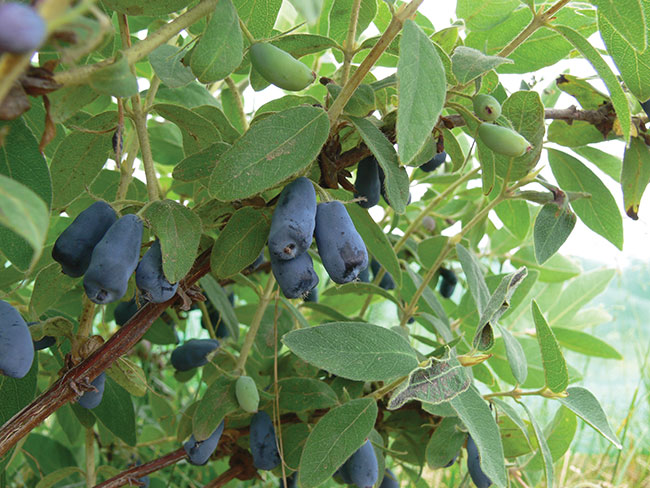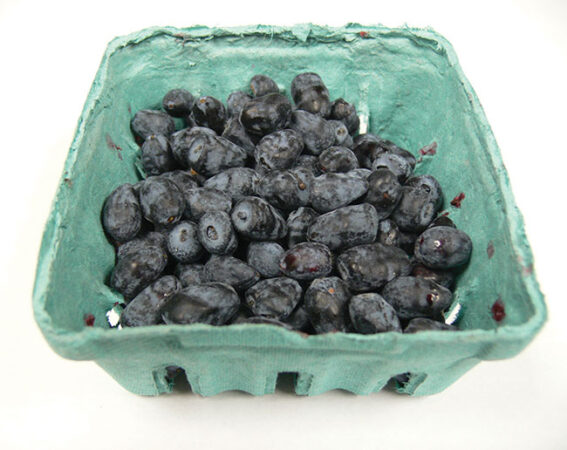
Features
Focus on: Berries
Fruit
Seeds of opportunity: Haskap berries
While it’s not yet suited to stock grocery store shelves, haskap is a solid option for those looking to try a different kind of berry.
March 27, 2023 By J.P. Antonacci
 Photos courtesy of Evan Elford, OMAFRA.
Photos courtesy of Evan Elford, OMAFRA. As a new crop development specialist in craft beer-obsessed Ontario, it’s no surprise Evan Elford is most often asked about growing hops.
The next crop he hears about is perhaps less obvious.
“Haskap is generally the second-most popular crop that I receive inquiries about for both commercial production and home gardens,” says Elford, the new crop development specialist for the Ontario Ministry of Agriculture, Food and Rural Affairs (OMAFRA), who works out of the agricultural research station in Simcoe, Ont.
Since commercial production began in Ontario around 15 years ago, haskap has become the largest specialty berry crop by acreage in the province, with more than 200 acres under cultivation. Yet most consumers still have no idea what a haskap berry is, says Graham Gambles, a board member with the Haskap Berry Growers of Ontario.
“Ninety-five per cent of the public are yet to taste a haskap,” says Gambles, who has 3,000 haskap plants on four acres in Temiskaming District, north of Sudbury.
The former vegetable farmer started growing haskap in 2014 after touring the University of Saskatchewan’s research haskap orchard, where plant scientist Bob Bors, Canada’s leading haskap expert, developed a number of cultivars suited for Canadian growing conditions.
“Loved the taste of the best ones,” Gambles recalls. “Superior to blueberries.”
Haskap, also known as edible blue honeysuckle or honeyberry, is a fast-growing berry akin in colour and consistency to blueberries, but with tangy notes of raspberry and rhubarb.
Found growing wild in the cold northern boreal forests of Canada, Russia and Japan, haskap are high in vitamin C and polyphenols and packed with more antioxidants than blueberries. These medicinal properties make the fruit and leaves a go-to treatment for fever and stomach pain, while the frozen berries are popular in smoothies. Haskap berries are also eaten fresh and processed for use in jam, wine, syrup, juice, ice cream and baked goods.
In Canada, the commercial haskap industry emerged in 2007, largely in Quebec, where the fruit is known as camerise. Today, the hardy perennial can be found everywhere from the harsh climes of northern Ontario and Quebec to the warm, humid southwest coast of British Columbia.
“Haskap is one of a few horticultural fruit crops that can thrive in parts of northern Ontario, which is helpful for diversifying production and markets in that area of the province,” Elford says.
Slow to grow, then watch them go
On average, haskap plants take four years to bear fruit. But once they hit their stride, plants can produce for 25 to 40 years.
“They are easy to grow, but very slow in the first few years,” says Gambles, who recommends transplanting from tissue culture in the fall, as the bushes grow larger the following summer after overwintering in the orchard.
Cross-pollination is needed for better fruit set, with a suggested ratio of one pollenisor plant for every eight main variety plants.
“Pollination in year four is critical,” Gambles says. “That will be the first large yield, but only if there are lots of pollinators available early in the season.”
Haskap blooms even before dandelions, when there are few wild pollinators making the rounds. Growers can consider contracting domestic beehives to ensure a high yield. Keeping a ring of standing hay around the orchard may encourage wild bees to nest there overwinter.
Growers should plant rows three metres apart and use plastic mulch to control weeds, while avoiding commercial fertilizer for the first three years in favour of keeping 10 per cent organic matter in the soil. “Preferably well-rotted dairy manure,” Gambles says. “The high calcium content seems to go directly to the leaves, as shown by plant tissue tests.”
Once the plants start producing, Gambles suggests pruning lower stems to allow for airflow and discourage diseases like powdery mildew.
Cultivating knowledge
The haskap varieties developed by Bors at the University of Saskatchewan can be grouped seasonally – early summer versus midsummer, for example – to allow for ideal cross-pollination and extend the pick-your-own and farmers’ market season. But determining the best cultivars to plant differs from region to region and even farm to farm.
Part of the problem, Elford says, is a lack of experience growing the same cultivars in a variety of hardiness zones and conditions.
“Many growers begin with four or more cultivars and evaluate how well they do on their particular site for their specific end uses,” Elford says, noting that newer haskap cultivars have been bred as eating and cooking berries, while some older cultivars were bred for ornamental purposes.
To deepen their understanding of haskap, Elford and his colleagues conduct cultivar trials, evaluate various ripening and harvest products, and study harvest timing by cultivar. Plans are in the works to establish a nitrogen fertility trial for haskap as well.
Gambles finds his customers prefer the Aurora variety, as its skin is slightly harder and therefore less susceptible to bruising when picked.
“It is not the first to ripen, however. It’s about three weeks behind Tundra, the earliest variety,” he says. “Customers wait for Aurora to ripen, so an orchard with 50 per cent Aurora could work well.”
Developing new varieties that have Aurora’s skin hardiness will allow haskap to hold its own with blueberries, blackberries and raspberries, Gambles says. “Otherwise, prepare to freeze the crop and sell in a format that can be held for months without spoilage.”
The roughly 20 members of the growers association collaborate with research institutions like Collège Boréal in Ontario, the University of Guelph and OMAFRA on projects that include evaluating the presence of virus in trialed haskap plants, finding the varieties most resistant to insect and disease pressure, and how best to overcome poor pollination and preserve the berries after harvest.
Since 2015, haskap growers have worked with Agriculture and Agri-Food Canada’s Pest Management Centre to develop and secure regulatory approval for fungicides to counter powdery mildew, herbicides to control weeds, and insecticides to address pest pressure, though those options remain limited.
“A lot of trial-and-error on-farm research is being done by growers in the industry,” Elford says. “Birds are by far the biggest issue in haskap, as they forage on ripening and ripe berries.”
Rabbits and deer looking for a snack can also damage the plants, while researchers are keeping an eye on the potential threat posed by spotted wing drosophila.

Haskap’s early season can extend pick-your-own offerings.
First blush
When haskap harvest nears, appearances can be deceiving.
“Do not harvest when the fruit first turns blue. They are green inside, and sour,” Gambles says.
In Ontario, haskap fruit begins to ripen at the end of May, but it will be several weeks, or even a month, before the berries’ skin exhibits the telltale deep purple indicating the sugar content is high and they are ready to plucked off the bush – either by hand or using a mechanical harvester, depending on the size of the orchard.
Once harvested, berries can be frozen directly on aluminum trays without washing. The wax on their skin will allow for later separation.
Gambles predicts it may take another 20 years before haskap berries turn up in grocery stores, even seasonally. “The problem is the requirement for hand harvest,” he says.
Other than the Aurora variety, the fruit blemishes too easily to be rolled on a mechanical harvester or shaken loose by a leaf blower. And any berries gathered with the help of picking aids must still be cleaned and sorted by hand.
“If there is red juice on your hands or equipment, you have 24 hours to sell, freeze or juice the day’s pickings,” Gambles says.
Much to learn
Though interest in haskap is growing, Elford says many unknowns remain.
“Very little replicated research has been conducted to date on haskap – such as general agronomics, pollination biology, pest management and post-harvest – compared to other small fruit crops,” he says.
“We base many of our recommendations on research conducted in similar crops, but work needs to be completed specifically on haskap to verify if those recommendations actually provide optimal production (and) yields over the long term.”
Gambles says the association is “working toward the day when Ontario growers will be able to purchase virus-indexed plantlets grown in Ontario.”
“The haskap industry is still in its infancy,” he says. “Growers need to trade stories, both positive and negative. You learn more from disasters.”
In Gambles’ experience, most consumers find they like the taste of haskap. The trick is getting them to try it. He advises growers to give away most of their initial crop to create a customer base at their local market. “The people will remember you and look forward to buying in quantity the next year, when you have a huge yield to get rid of,” he says.
Elford agrees that more marketing will be key to making haskap a commercially viable berry crop.
“As with any new crop, consumer recognition and educating consumers on when the crop is available and how to use the crop is a primary consideration,” he says.
“Awareness has increased over the last decade. However, there is still a lot of work to be done for general recognition by consumers. I think it is still too soon to say. We will have to see how acreage changes over time, along with market uptake by consumers, to see if this will be a successful crop for the long term.”
Print this page